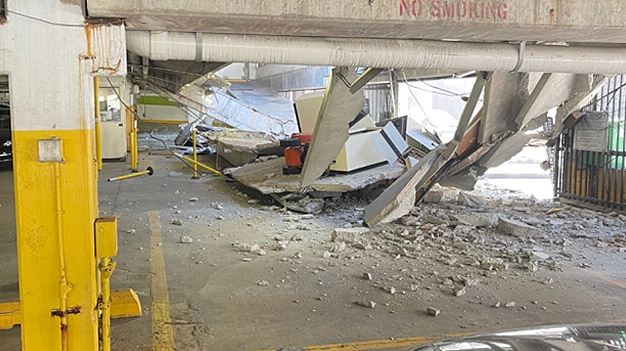“Parking Structures have the lowest factor of safety built into their design. Couple that with poor inspection and maintenance practices, and you have a recipe for a very expensive problem”
If you google parking structure collapse or damage, you will find there are quite a few instances around the United States on a yearly basis. Some are quite sensational, others caught in the nick of time before someone was injured or killed. If you consider the actual number of structure failures versus the number of parking structures, the number is miniscule, but the key element in every single story you read about is lack of inspection and maintenance coupled with the fact that parking structures have the lowest factor of safety built into the design. That statement alone should awaken every single property management company throughout the west. Poor inspection and maintenance practices coupled with a lower design safety factor, should open your eyes to the need for better management practices.
“Another flaw in the human character is that everybody wants to build, and nobody wants to do maintenance.” – Kurt Vonnegut
A little back story on structural design for parking structures.
Structural design is generally done by computing an anticipated load (how much will the stuff in the building will weigh), multiplied by a safety factor, and then designing a structure with enough strength to support that “factored” load. Modern building codes estimate the anticipated strength as less than it actually is, (for errors in materials/construction). Structures generally end up with at least 3 times as much strength as they need. So, the building you are sitting in is quite safe. Unfortunately, parking structures typically have the lowest factor of safety built into their design, thusly they fail much more often than other building types because they’re so cheaply constructed or the loading is so much lighter than other types of structures that factoring doesn’t increase the loading by as many tons, and finally failures rarely result in loss of life.
Parking structures, especially pre-stressed concrete structures are designed so that if they fail, the rebar, (steel), is the last thing to go, which will stretch gradually when failure begins so that people have a chance to “get the heck out”. The alternative failure is what’s called a brittle failure, where there’s just one loud pop and then bam, collapse occurs with no warning at all.
Engineers always talk about this stuff in terms of ‘strain’ and ‘yield.’ Strain is how much a material can deform (stretch or compress). When the strain gets too much, the structure ‘yields’ or permanently deforms. For a concrete structure, deform means eventual collapse. The last thing to go before a concrete structure collapse is the reinforcing steel, which has a maximum strain of about 0.02 (2%) before yielding. That means if the clear span (beam-to-beam distance) is 30 feet, you can have a sag of 30 ft / 2 * 0.02 – 3.6 inches before it actually damages the structure. Parking garage widths are typically 64 feet, which can have 7.5 inches of sag in the middle, far more than the allowable sag for potential damage. Combine this with environmental conditions that allow water and salts to reach the embedded steel, and you have a recipe for a potential collapse, or at the very least, a very expensive repair project.
So, now you know a little about all those parking structures you manage. Would you be interested to find out the condition of them as well? Foundation Tech, Inc. offers detailed inspection reports and structural assessments along with ACI certified structural concrete repair services throughout the western states.

